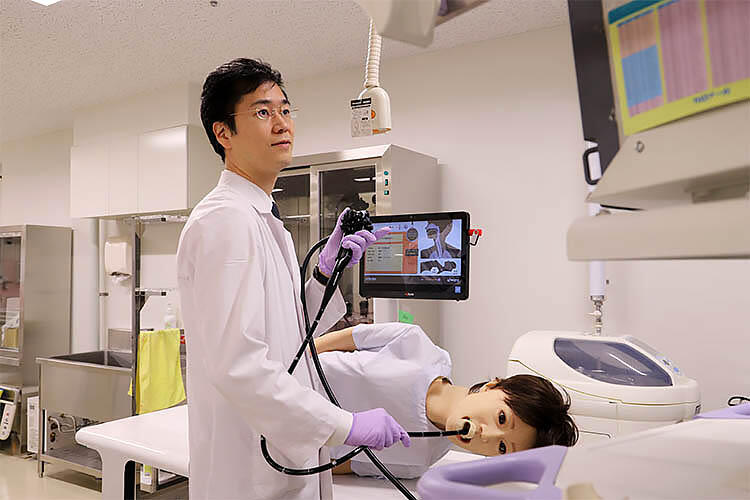
(Provided by Yonago-City)
In the second installment of the feature, "Inventors who create the future," we interviewed Masaru Ueki, Faculty of Medicine Tottori University professor, who proposes "Hatsumei-gaku." Hatsumei-gaku is a method of getting inventions from accumulated awareness. He says that using this technique enables anyone to invent something.
Working on making painless and safe endoscopes
Masaru Ueki, a gastroenterologist specializing in medicine, devised the "Hatsumei-gaku," a method to generate "inventions," and has been working to spread the word about it. What would be the catalyst for connecting the seemingly distant medicine and invention?
Ueki has been developing "endoscopes" that are patient-friendly and safe to use. An endoscope is a medical device that can observe lesions inside the digestive organs without damaging the body. For observation, a tube is inserted with a built-in camera at the tip into a human body through the mouth, nose, or anus.
However, he often encountered patients who looked pained due to the gag reflex because of the endoscope irritating the back of their throat during insertion. Furthermore, forcing an endoscope which has hit the intestine wall to go deeper risked tearing the intestine, causing more than just pain. "Why is it so painful? Can't there be safer endoscopes?" While providing medical care, Ueki began to think about this constantly.
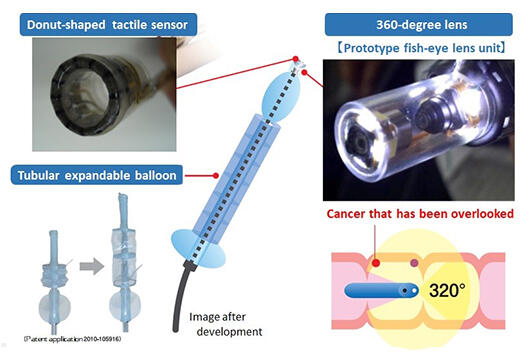
(Original image was provided by Ueki and has been translated by JST)
Ueki, who has been fond of invention since he was a child, has always believed that combining things or perspectives that already existed would create new things or technologies. Moreover, he attended academic meetings in fields outside of medicine for clues to his development, to realize that "there were many advanced technologies out there, which he had not just noticed." It made him aware of the possibility of creating new products or values by combining the existing knowledge or technologies possessed by different fields.
From these accumulated experiences and discoveries, he came up with the four skill structures "Hatsumei-gaku," which generate invention.
Skill structures of addition, subtraction, multiplication, and division, by which anyone can generate inventions
What exactly is an invention? Is it something that only particular people with extraordinary talents can achieve? Ueki says that "invention does not require talent, but skill," and that anyone can make an invention by using the four arithmetic skill structures of "Hatsumei-gaku."
For example, an eraser pencil is an invention; combining a pencil and an eraser made it slightly more convenient. In the medical field, there is a practical example too. Adding the function of a microscope to a camera that observes lesions created a technology that allows for magnified observation. If we use the idea of "adding" something to something, we may find hints for inventions infinitely.
The technique for creating inventions is not limited to this idea of addition. There are also techniques of subtraction, multiplication, and division.
For example, slippers that had been too small in size became popular because of the expected weight-loss effect from standing on tiptoes. It is an example of how an unexpected impetus became an invention, which Ueki explains as the idea of "subtraction" that makes things smaller.
"Multiplication" is a diversion idea of creating something new by applying knowledge or technology that is considered a matter of course in a different field to some other area. Furthermore, "division," also called the inverse number, is an inverted idea that things or technologies that everyone deems a failure could become an invention if looked at in a different light. In fact, many inventions were born this way. For example, easy to remove glue was created as a failed product while developing a hard-to-peel-off glue. It was diverted and became a sticky note that could be stuck and peeled off.
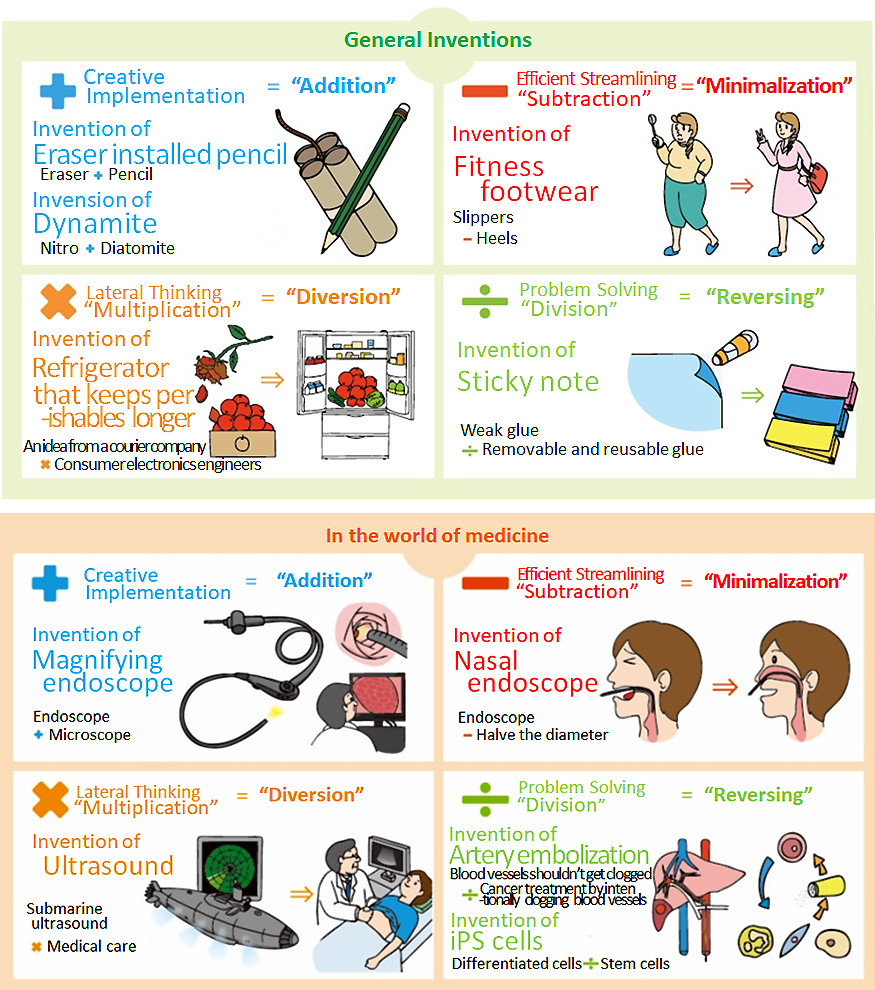
(Original image was provided by Tottori University Hospital and has been translated by JST)
The Goddess of invention descends on the prepared mind
Quoting the words of the French bacteriologist Pasteur, Ueki says, "The Goddess of invention descends on the prepared mind."
Should there be something you feel is in short, wish you had, or want to solve, you should cherish the awareness first. Then, if you come up with an idea, save it as material for invention. When this preparation and any of the four arithmetic concepts overlap, an invention comes to your mind at a moment's notice.
Through his endoscope development, Ueki realized the high level of Japan's technology and its potential to change the world's medical care for the better. He says, "In thinking about the future in 2050, I believe that human resources and intellectual property will save Japan. It is particularly important to nurture human resources who can create inventions and innovations."
"Hatsumei-gaku" includes the dream and wish that "Japan will change the future with inventions. Let's create a better world." It became class content for medical students and passed down to today's classes and workshops for elementary to high school students as well as adults.
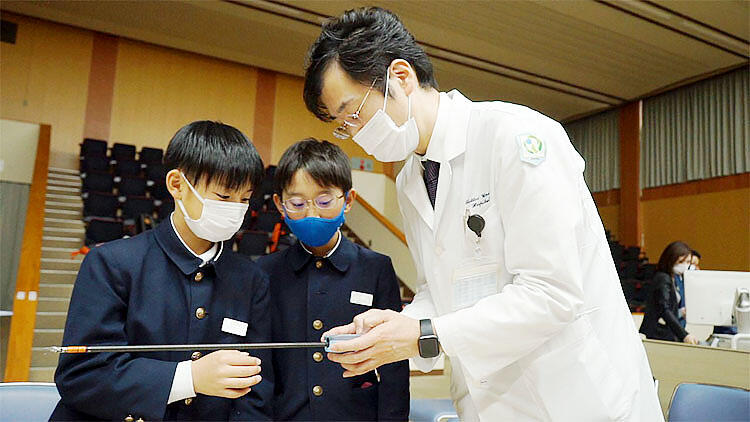
(Provided by Tottori University Hospital)
From exciting fun to sense of fulfillment
If your idea is of help in the form of a product, your daily work will become enjoyable and encouraging. More and more medical people who had got to know "Hatsumei-gaku" reached out to Ueki to bring their ideas. Indeed, there were 26 cases of commercialization of ideas to solve problems and shortages encountered in the field. People who have had the experience of putting out ideas and solving problems look very animated. He saw such an appearance on many occasions.
Ueki says that an invention is "not only fun and games, but also a time to think of something that helps or benefits someone." As he repeatedly witnessed the final moments of people's lives as a physician, he came to realize that life is finite and the importance of having heart and time to sense happiness. An invention that he has been familiar with since he was a child is the act of making something with someone who will use it in mind. It creates a mental activity that makes the inventor feel happy as well. It also increases opportunities to connect and cooperate with others to realize invention ideas, leading to subliming into a great sense of accomplishment and fulfillment.
Inventions created in this way, even after they have left the inventor's hands and become independent, are helpful to many people and create a chain of happiness. Having an idea of invention in your life may change your life into a richer and more enjoyable one.
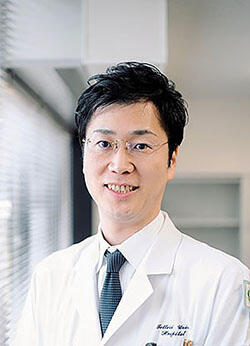
UEKI Masaru
Ph.D. in Medicine, Professor, Division of Medical Education, Faculty of Medicine Tottori University
Lecturer at the Center for Clinical Residency Program, Tottori University Hospital in 2009, Specially Appointed Associate Professor at the Center for Promoting Next-Generation Highly Advanced Medicine (Current name: AMIRT, Advanced Medicine, Innovation and Clinical Research Center) of the same hospital in 2012, and Professor at the same center in 2014, before he assumed the current position. He started giving classes based on Hatsumei-gaku in 2012 and has been developing workshops, contests, etc., since 2019.
Original article was provided by the Science Portal and has been translated by Science Japan.




